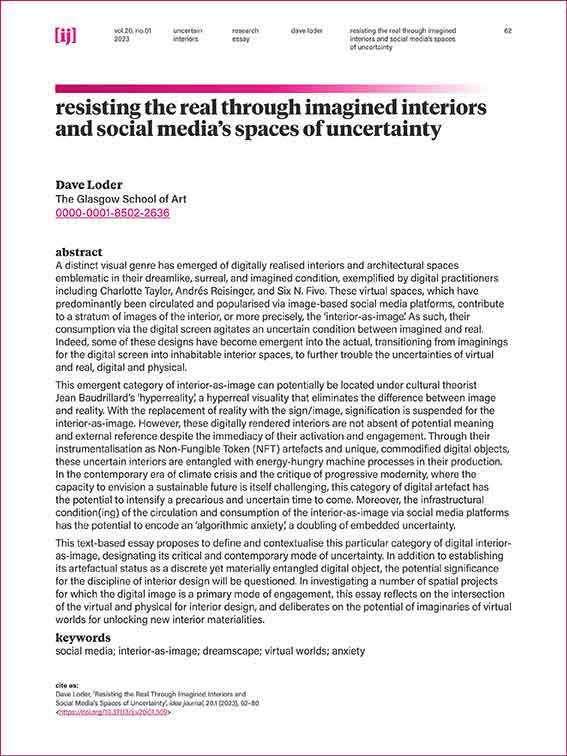Resisting the Real Through Imagined Interiors and Social Media’s Spaces of Uncertainty
Main Article Content
Abstract
A distinct visual genre has emerged of digitally realised interiors and architectural spaces emblematic in their dreamlike, surreal, and imagined condition, exemplified by digital practitioners including Charlotte Tayler, Andrés Reisinger, and Six N. Five. These virtual spaces, which have predominantly been circulated and popularised via image-based social media platforms, contribute to a stratum of images of the interior, or more precisely, the ‘interior-as-image’. As such, their consumption via the digital screen agitates an uncertain condition between imagined and real. Indeed, some of these designs have become emergent into the actual, transitioning from imaginings for the digital screen into inhabitable interior spaces, to further trouble the uncertainties of virtual and real, digital and physical.
This emergent category of interior-as-image can potentially be located under cultural theorist Jean Baudrillard’s ‘hyperreality’, a hyperreal visuality that eliminates the difference between image and reality. With the replacement of reality with the sign/image, signification is suspended for the interior-as-image. However, these digitally rendered interiors are not absent of potential meaning and external reference despite the immediacy of their activation and engagement. Through their instrumentalisation as Non-Fungible Token (NFT) artefacts and unique, commodified digital objects, these uncertain interiors are entangled with energy-hungry machine processes in their production. In the contemporary era of climate crisis and the critique of progressive modernity, where the capacity to envision a sustainable future is itself challenging, this category of digital artefact has the potential to intensify a precarious and uncertain time to come. Moreover, the infrastructural condition(ing) of the circulation and consumption of the interior-as-image via social media platforms has the potential to encode an ‘algorithmic anxiety’, a doubling of embedded uncertainty.
This text-based essay proposes to define and contextualise this particular category of digital interioras-image, designating its critical and contemporary mode of uncertainty. In addition to establishing its artefactual status as a discrete yet materially entangled digital object, the potential significance for the discipline of interior design will be questioned. In investigating a number of spatial projects for which the digital image is a primary mode of engagement, this essay reflects on the intersection of the virtual and physical for interior design, and deliberates on the potential of imaginaries of virtual worlds for unlocking new interior materialities.
Article Details
Author/s and or their institutions retain copyright ownership over works submitted to Idea Journal, and provide the Interior Design / Interior Architecture Educators Association with a non–exclusive license to use the work for the purposes listed below:
- Make available/publish electronically on the Idea Journal website
- Publish as part of Idea Journal's online open access publications
- Store in electronic databases, on websites and CDs/DVDs, which comprise of post-publication articles to be used for publishing by the Interior Design / Interior Architecture Educators Association.
Reproduction is prohibited without written permission of the publisher, the author/s or their nominated university. The work submitted for review should not have been published or be in the process of being reviewed by another publisher. Authors should ensure that any images used in their essays have copyright clearance.

